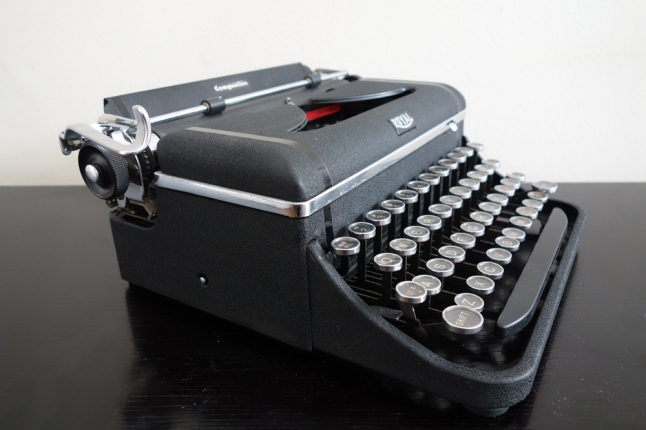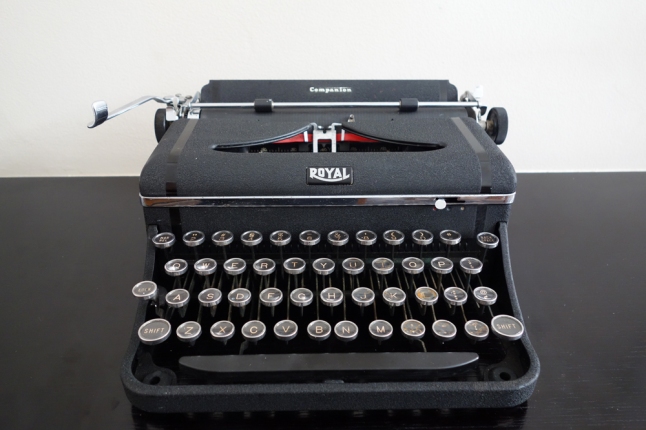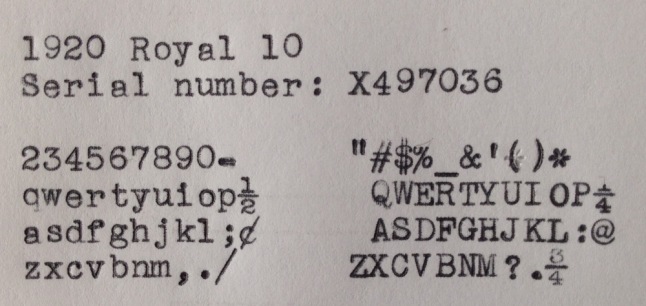A couple weeks ago, Moe at my favorite junk shop asked me to take a look at her friend Tim’s typewriters. Tim is a retired newspaper reporter who has a taste for fine old typewriters.

One typewriter was a 1950s Royal Quiet De Luxe that was very dirty. It also had a broken drawband. There was a slightly-typed piece of paper in the platen. Looks like Tim got through one line before the old drawband snapped.
There was a weird white residue on this QDL that I have seen before on typewriter keys. My guess is that it’s a chemical precipitate that forms on 1950s plastic. There is another 1950s Royal Quiet De Luxe at Typewriter Database with a very similar residue on its keys.

The other typewriter was a very dirty 1940 Royal Companion. It had a gummy and rusted segment, an unreliable ribbon vibrator, intermittent spooling and no bell. It looked very haggard.



I started with the Royal Quiet De Luxe because it seemed to have the fewest problems. I blew out the dust and cobwebs, cleaned with mineral spirits and PB B’laster and replaced the draw band (14 inches long) with my favorite bit of overkill, 80 lb fishing line:

80lb line – suitable to landing one of the larger species of sportsfish – or replacing the drawband on an old typewriter.
Gosh, it cleaned up beautifully:

The white residue on the keys came right off with Goo Gone:


Look at those beautiful little decorative accents:

The 1940 Royal Companion was a bit worse for the wear of years. Fortunately the splatters across the shell cleaned up nicely with Scrubbing Bubbles. I blew out the internal mechanics and cleaned the segment thoroughly with mineral spirits. After getting the stuck keys moving, I set about trying to figure out why the ribbon vibrator, the ribbon color switcher, ribbon advance, bell and margin release weren’t working. The machine was missing some springs from the bottom. I saw some tell-tale holes in the frame and in pieces in the mechanics and did some detective work looking at fuzzy “bottom shots” of Companions on eBay.
I found some motley springs. I don’t know for sure if that’s where they go, but everything seems to work better with them:

That’s a ballpoint pen spring for the bell – looks terrible, but it works.

The margin release was trickier. It wasn’t pulling the center stop back far enough to clear the margin stop, so hitting the margin release key was doing nothing. I bent a little wire connector inside the typewriter to make it shorter. I got the idea from Knife141’s solution. That guy. Gets. It. Done.
That seemed to do the trick:

The Champion is a teeny little thing, very lightweight. It cleaned up beautifully. In person, it is just adorable, a teeny little huggable package, slightly smaller than a Royal QDL.



A commenter on my blog recently pointed out that I seemed to be running a “revolving door” operation. I know that it looks unseemly with strange typewriters coming in and out of my house regularly, but I assure you: I am a respectable suburban housewife, married, mother of two. There is nothing illegal going on in my home. I am just helping needy typewriters.

These two from The Shop at Flywheel Press stayed for a short time. The electric Penncrest Concord PCR 12 (a Smith-Corona made for JC Penny department stores) had four sprung clevis linkages. I found reattaching clevis linkages on this electric so much more difficult than on a manual Smith-Corona because the key arms don’t move without being initiated by an electric key strike. But! I managed to reattach them and the Penncrest types again:

I found this drawing in the documents library at Typewriter Database:


Service Manual, Smith-Corona “5 and 6 Series” Machines – 1963 Details adjustment and inspection of all Smith-Corona 5 and 6 Series Floating Shift portables. From the collection of Bill Wahl, scanned and PDF by T. Munk.
Ha! That’s what I have been dealing with for the past few weeks: S-C linkages. The authors of the manual call that typebar linkage a typebar link spring. I will continue to call it a clevis because it sounds vaguely anatomical.

Such a FUN typewriter – but pretty noisy.
The Royal 10 is a real honey. It was a victim of congealed gunk. The ribbon vibrator was stuck in the up position, the line lock failed to disengage, spooling was intermittent, margin release stuck. It was just really dirty. The stiff and frozen parts responded to strategic application of PB B’laster and manually moving the parts with my hands. I bought a new Royal 10 style ribbon from Amazon and got down to typing:

WOW! This Royal 10 reminds me of the Foster Royal KHM that visited me briefly. It must be that “accelerating type-bar action“. This typewriter seems to type all by itself. In fact, I walked out of the room and came back to find the Royal 10 typing a letter to the editor of the local paper rejoicing in the ratification of the Nineteenth Amendment. That Royal 10 is a right-on kind of typewriter.
The machine appears to have been re-painted at some point: the top, front plate and paper table are a matte crinkle paint while the sides are glossy black. The decal in front of the type basket is missing and decal on the paper table looks newer than a 1920 decal:

Still a very handsome machine and a very springy 96 year old typer.

I bought the Royal-style ribbon spools on Amazon.

Fun post, great machines, keep ’em on the road!
LikeLike
I do believe you are at the point of needing to add “Repair Shop” to your blog’s title. Give it a year, and all the typewriters of California will be in working condition!
LikeLike
Some fine looking machines there! Good work!
LikeLike
Lovely lovely work. I would be tempted to keep that electric just for its typeface!
LikeLike
I think my line lock is failing to disengage as well. Can you give me any tips on how to fix it?
LikeLike
The failure to disengage problem with my Royal 10’s line lock was due to gummy, congealed gunk. I doctored all the connections related to the line lock with PB B’laster (you could use mineral spirits or denatured alcohol – just don’t get it on the paint) and moved them with my hands until the parts moved freely. Here is an online typewriter manual that described the parts of the line lock system:
http://archive.hnsa.org/doc/typewriter/part2.htm#pg58
Read through page 58 and check out the diagram on page 59. Old Royals like Royal 10s don’t have “Magic Margins” but I think the line lock set up is the same. Good luck!
LikeLike
I have the same “problem”…just love writing on a typewriter so I can’t stand seeing one in bad condition and I’ll pick them up wherever I can and clean them up. The mechanical stuff can get tricky and there just ain’t no repairmen around anymore so when you run into a really tricky repair you might just get stuck. But bravo for you and keep up the good work.
LikeLike
You know the satisfaction of taking a junky, discarded typewriter and turning it into a really nice typing machine.
LikeLike